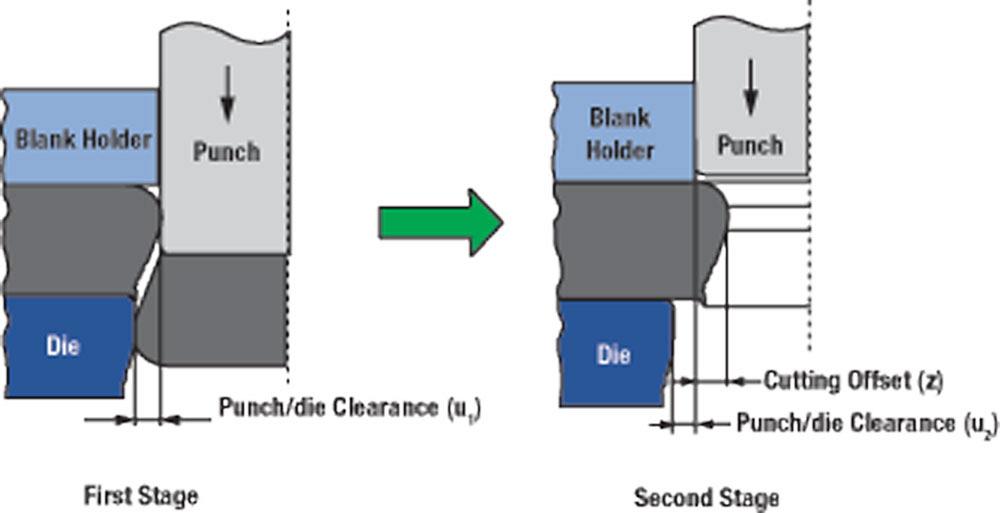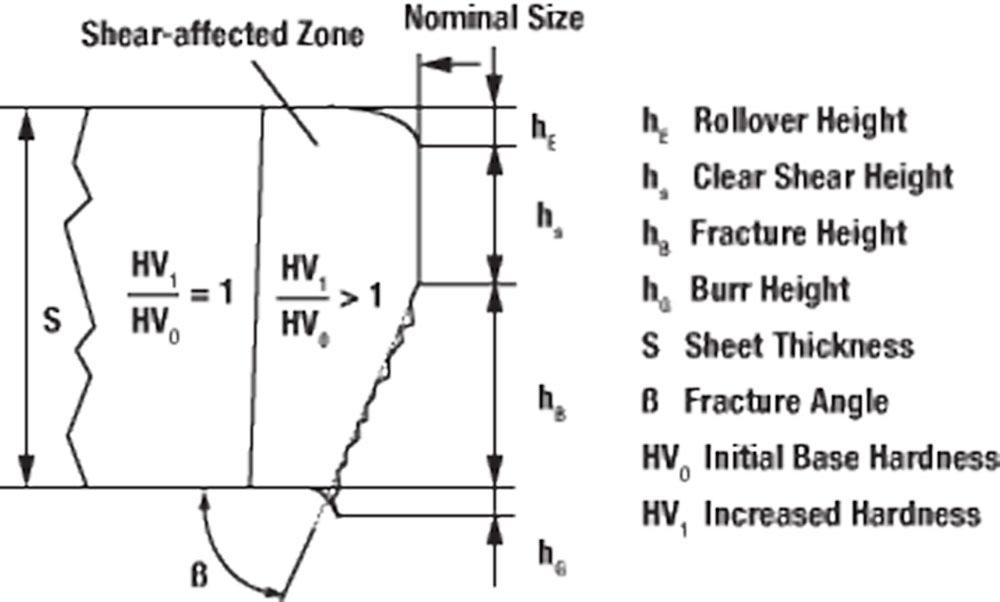Graduate Research Associate
- FMA
- The Fabricator
- FABTECH
- Canadian Metalworking
Categories
- Additive Manufacturing
- Aluminum Welding
- Arc Welding
- Assembly and Joining
- Automation and Robotics
- Bending and Forming
- Consumables
- Cutting and Weld Prep
- Electric Vehicles
- En Español
- Finishing
- Hydroforming
- Laser Cutting
- Laser Welding
- Machining
- Manufacturing Software
- Materials Handling
- Metals/Materials
- Oxyfuel Cutting
- Plasma Cutting
- Power Tools
- Punching and Other Holemaking
- Roll Forming
- Safety
- Sawing
- Shearing
- Shop Management
- Testing and Measuring
- Tube and Pipe Fabrication
- Tube and Pipe Production
- Waterjet Cutting
Industry Directory
Webcasts
Podcasts
FAB 40
Advertise
Subscribe
Account Login
Search
R&D Update: Edge fracture in hole extrusion and flanging, Part II
How shaving can reduce fracture in collar forming
- By Advaith Narayanan, David Diaz-Infante, Dr., and Taylan Altan, Ph.D.
- October 11, 2018
- Article
- Bending and Forming
Two-stage blanking, also known as shaving, can be used to improve edge stretchability. With this method, the operator blanks an initial hole of a smaller diameter than the desired hole. Then a larger hole is blanked with the desired dimensions before collar forming.
Shaving has been shown in research and practical experience to reduce edge fracture in collar forming (see Figure 1). Variables that affect this operation are the punch/die clearances (u1, u2) and the blanking offset (z).
Effect of Strain Hardening/Hardness
In blanking and shearing operations, very high strains develop near the sheared edge after cutting. This means the material is significantly strain-hardened, leaving little room for additional stretching during subsequent operations, especially when blanking advanced high-strength steels (AHSS).
Recent studies conducted at Technical University of Munich (TUM) concluded that hardness near the sheared edge, or shear-affected zone (see Figure 2), is directly correlated to edge fracture during collar forming. Researchers observed that the shaving leads to lower strain hardening than in single-stage blanking.
To investigate how local hardening in blanking affects edge fracture in collar forming, researchers evaluated the edge stretchability achieved for different blanking clearances (u1, u2) and cutting offsets (z) using the hole expansion ratio (λ). A higher λ value indicates better edge stretchability in collar forming. λ is determined by:
λ (in %) = (D-d x 100)÷ d
Where:
- D = Diameter of punch during collar forming
- d = Diameter of blanked hole before collar forming
At TUM, researchers performed collar forming tests on CP-W 800 cold-rolled steel, 4 millimeters thick. The first series of tests used a 50-mm-diameter hole, blanked at various punch-die clearances between 5 and 30 percent of the sheet thickness. The maximum hole expansion ratio (λ) that could be achieved was about 5 percent. As a comparison, collar forming using a machined (milled) hole could yield a hole expansion ratio of nearly 90 percent.
Additional tests used punch/die clearances of 10 and 15 percent in two consecutive shaving operations respectively. The second operation used cutting offset values (z) of 2, 3, and 4 mm. The results indicated that the selected shaving-tool geometries could produce a hole expansion ratio (λ) up to 40 percent.
These results clearly show that, for certain AHSS, shaving may be a useful technique to reduce or postpone the probability of edge fracture in collar forming. Obviously, additional studies may be needed to investigate the quantitative selection of shaving conditions for other AHSS material and thicknesses.
Estimating Tool Dimensions to Reduce Edge Fracture
To replicate the experimental results obtained at TUM, researchers at The Ohio State University’s Center for Precision Forming conducted finite element (FE) simulations on different AHSS of varying thicknesses. Their goal was to estimate the tool dimensions for shaving that would reduce edge fracture in collar forming.
Figure 3 shows the schematic of the collar forming operation that underwent FE simulations. The distribution of strains generated in single-stage blanking and shaving, using the FE method, is shown in Figure 4. The strain values, obtained as a function of distance from the blanked edge, are shown in Figures 5 and 6 at two different locations in the thickness of the blank. These results also show, as did the studies conducted at TUM, that shaving leads to a relatively softer blanked edge and reduces the probability of edge fracture in a collar extrusion.
The strains, estimated in collar forming with and without a secondary shaving operation, are shown in Figure 7. The strains at the edge of the formed collar obtained in both cases show that shaving reduces the strains and consequently the chances of potential fracture.
It is necessary to predict at what edge strain or edge thinning level that fracture may occur. Studies are in progress to determine a relationship among strain hardening, edge thinning, and the probability of fracture for different AHSS and thicknesses.
References
I. Pätzold, F. Dittmann, M. Feistle, R. Golle, P. Haefele, H. Hoffmann, and W. Volk, “Influence of shear cutting parameters on the fatigue behavior of a dual-phase steel,”
Journal of Physics: Conference Series, Vol. 896, No. 1 (2017), p. 012107.M. Feistle, I. Pätzold, R. Golle, W. Volk, A. Frehn and R. Ilskens, “Maximizing the expansion ratio through multi-stage cutting process during collar-forming,” 37th International Deep Drawing Research Group Conference, Waterloo, Canada, 2018.
I. Pätzold, M. Feistle, R. Golle, W. Volk, A. Frehn and R. Ilskens, “Determination of the minimum possible damage due to shear cutting using a multi-stage shear cutting process,” 37th International Deep Drawing Research Group Conference, Waterloo, Canada, 2018.
About the Authors
Advaith Narayanan
Center for Precision Forming
The Ohio State University 1971 Neil Ave., Room 339 Baker Systems Engineering Building
Columbus, OH 43210
(614) 292-5063
David Diaz-Infante, Dr.
Servo Press Scientist
250 W 5th St.
Minster, OH 45865
o 419 628 2331, d 419 501 1890, m 419 733 7971

Taylan Altan, Ph.D.
Professor Emeritus and Director - Center for Precision Forming
Related Companies
subscribe now

The Fabricator is North America's leading magazine for the metal forming and fabricating industry. The magazine delivers the news, technical articles, and case histories that enable fabricators to do their jobs more efficiently. The Fabricator has served the industry since 1970.
start your free subscription- Stay connected from anywhere

Easily access valuable industry resources now with full access to the digital edition of The Fabricator.

Easily access valuable industry resources now with full access to the digital edition of The Welder.

Easily access valuable industry resources now with full access to the digital edition of The Tube and Pipe Journal.
- Podcasting
- Podcast:
- The Fabricator Podcast
- Published:
- 04/16/2024
- Running Time:
- 63:29
In this episode of The Fabricator Podcast, Caleb Chamberlain, co-founder and CEO of OSH Cut, discusses his company’s...
- Trending Articles
Tips for creating sheet metal tubes with perforations

Supporting the metal fabricating industry through FMA

JM Steel triples capacity for solar energy projects at Pennsylvania facility

Are two heads better than one in fiber laser cutting?

Fabricating favorite childhood memories

- Industry Events
16th Annual Safety Conference
- April 30 - May 1, 2024
- Elgin,
Pipe and Tube Conference
- May 21 - 22, 2024
- Omaha, NE
World-Class Roll Forming Workshop
- June 5 - 6, 2024
- Louisville, KY
Advanced Laser Application Workshop
- June 25 - 27, 2024
- Novi, MI





























